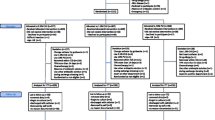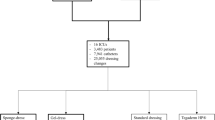Abstract
Purpose
Compare the effectiveness of different cutaneous antiseptics in reducing risk of catheter-related infection in intensive care unit (ICU) patients.
Methods
We compared the risk of central venous catheter-related infection according to four-step (scrub, rinse, dry, and disinfect) alcoholic 5 % povidone–iodine (PVI-a, n = 1521), one-step (disinfect) alcoholic 2 % chlorhexidine (2 % CHX-a, n = 1116), four-step alcoholic <1 % chlorhexidine (<1 % CHX-a, n = 357), and four-step aqueous 10 % povidone–iodine (PVI, n = 368) antiseptics used for cutaneous disinfection and catheter care during the 3SITES multicenter randomized controlled trial. Within this cohort, we performed a quasi-experimental study (i.e., before–after) involving the four ICUs which switched from PVI-a to 2 % CHX-a. We used propensity score matching (PSM, n = 776) and inverse probability weighting treatment (IPWT, n = 1592). The end point was the incidence of catheter-related infection (CRI) defined as catheter-related bloodstream infection (CRBSI) or a positive catheter tip culture plus clinical sepsis on catheter removal.
Results
In the cohort analysis and compared with PVI-a, the incidence of CRI was lower with 2 % CHX-a [adjusted hazard ratio (aHR), 0.51; 95 % confidence interval (CI) (0.28–0.96), p = 0.037] and similar with <1 % CHX-a [aHR, 0.73; (0.36–1.48), p = 0.37] and PVI [aHR, 1.50; 95 % CI (0.85–2.64), p = 0.16] after controlling for potential confounders. In the quasi-experimental study and compared with PVI-a, the incidence of catheter-related infection was again lower with 2 % CHX-a after PSM [HR, 0.35; 95 % CI (0.15, 0.84), p = 0.02] and in the IPWT analysis [HR, 0.31; 95 % CI (0.14, 0.70), p = 0.005]. The incidence of CRBSI or adverse event was not significantly different between antiseptics in all analyses.
Conclusions
In comparison with PVI-a, the use of 2 % CHX-a for cutaneous disinfection of the central venous catheter insertion site and maintenance catheter care was associated with a reduced risk of catheter infection, while the benefit of <1 % CHX-a was uncertain.
Clinical trials identifier: NCT01479153.


Similar content being viewed by others
References
Mermel LA (2011) What is the predominant source of intravascular catheter infections? Clin Infect Dis 52:211–212
O’Grady NP, Alexander M, Burns LA et al (2011) Guidelines for the prevention of intravascular catheter-related infections. Am J Infect Control 39:S1–34
Mimoz O, Chopra V, Timsit J-F (2016) What’s new in catheter-related infection: skin cleansing and skin antisepsis. Intensive Care Med. doi:10.1007/s00134-016-4244-4
Maki DG, Ringer M, Alvarado CJ (1991) Prospective randomised trial of povidone–iodine, alcohol, and chlorhexidine for prevention of infection associated with central venous and arterial catheters. Lancet 338:339–343
Chaiyakunapruk N, Veenstra DL, Lipsky BA, Saint S (2002) Chlorhexidine compared with povidone–iodine solution for vascular catheter-site care: a meta-analysis. Ann Intern Med 136:792–801
Parienti J-J, du Cheyron D, Ramakers M et al (2004) Alcoholic povidone–iodine to prevent central venous catheter colonization: a randomized unit-crossover study. Crit Care Med 32:708–713
Maiwald M, Chan ESY (2012) The forgotten role of alcohol: a systematic review and meta-analysis of the clinical efficacy and perceived role of chlorhexidine in skin antisepsis. PLoS One 7:e44277
Mimoz O, Lucet J-C, Kerforne T et al (2015) Skin antisepsis with chlorhexidine-alcohol versus povidone–iodine-alcohol, with and without skin scrubbing, for prevention of intravascular-catheter-related infection (CLEAN): an open-label, multicentre, randomised, controlled, two-by-two factorial trial. Lancet 386:2069–2077
Parienti J-J, Mongardon N, Mégarbane B et al (2015) Intravascular complications of central venous catheterization by insertion site. N Engl J Med 373:1220–1229
Haute Autorité de Sante (2010) Check-list: pose d’un catheter veineux central (CVC) ou autre dispositif vasculaire (DV). http://www.has-sante.fr/portail/upload/docs/application/pdf/2011-01/11_01_check-list-cvc-dv.pdf. Accessed 8 June 2016
Brun-Buisson C, Abrouk F, Legrand P, Huet Y, Larabi S, Rapin M (1987) Diagnosis of central venous catheter-related sepsis. Critical level of quantitative tip cultures. Arch Intern Med 147:873–877
Raad I, Hanna HA, Alakech B, Chatzinikolaou I, Johnson MM, Tarrand J (2004) Differential time to positivity: a useful method for diagnosing catheter-related bloodstream infections. Ann Intern Med 140:18–25
Arpino B, Cannas M (2016) Propensity score matching with clustered data. An application to the estimation of the impact of caesarean section on the Apgar score. Stat Med 35:2074–2091
Austin PC, Grootendorst P, Anderson GM (2007) A comparison of the ability of different propensity score models to balance measured variables between treated and untreated subjects: a Monte Carlo study. Stat Med 26:734–753
Robins JM, Hernán MA, Brumback B (2000) Marginal structural models and causal inference in epidemiology. Epidemiol Camb Mass 11:550–560
Austin PC (2009) Balance diagnostics for comparing the distribution of baseline covariates between treatment groups in propensity-score matched samples. Stat Med 28:3083–3107
Cole SR, Hernán MA (2004) Adjusted survival curves with inverse probability weights. Comput Methods Programs Biomed 75:45–49
Bailly S, Pirracchio R, Timsit JF (2016) What’s new in the quantification of causal effects from longitudinal cohort studies: a brief introduction to marginal structural models for intensivists. Intensive Care Med 42:576–579
Hussey MA, Hughes JP (2007) Design and analysis of stepped wedge cluster randomized trials. Contemp Clin Trials 28:182–191
Parienti J-J, Cattoir V (2013) Daily chlorhexidine bathing and hospital-acquired infection. N Engl J Med 368:2331
Timsit J-F, Schwebel C, Bouadma L et al (2009) Chlorhexidine-impregnated sponges and less frequent dressing changes for prevention of catheter-related infections in critically ill adults: a randomized controlled trial. JAMA 301:1231–1241
McCann M, Fitzpatrick F, Mellotte G, Clarke M (2016) Is 2% chlorhexidine gluconate in 70% isopropyl alcohol more effective at preventing central venous catheter-related infections than routinely used chlorhexidine gluconate solutions: a pilot multicenter randomized trial (ISRCTN2657745)? Am J Infect Control. doi:10.1016/j.ajic.2016.02.019
Rijnders BJA, Van Wijngaerden E, Peetermans WE (2002) Catheter-tip colonization as a surrogate end point in clinical studies on catheter-related bloodstream infection: how strong is the evidence? Clin Infect Dis 35:1053–1058
Société française d’anesthésie et de réanimation, Société de réanimation de langue française (2009) [Prevention of hospital-acquired sepsis in intensive care unit (except cross transmission and neonate)]. Ann Fr Anesth Reanim 28:912–920
Pronovost P, Needham D, Berenholtz S et al (2006) An intervention to decrease catheter-related bloodstream infections in the ICU. N Engl J Med 355:2725–2732
Sherertz RJ, Ely EW, Westbrook DM et al (2000) Education of physicians-in-training can decrease the risk for vascular catheter infection. Ann Intern Med 132:641–648
Cooper K, Frampton G, Harris P et al (2014) Are educational interventions to prevent catheter-related bloodstream infections in intensive care unit cost-effective? J Hosp Infect 86:47–52
Acknowledgments
We thank the nurses, infecton control teams, clinical research assistants and physicians in the participating centers. We also thank Cynthia T. Crosby from the Department of Clinical Research, CareFusion (BD), San Diego for providing alcoholic chlorhexidine at no cost.
Author information
Authors and Affiliations
Consortia
Corresponding author
Ethics declarations
Conflicts of interest
JJP received research grants through his institution and personal fees from CareFusion. LAM received research grant support and personal fees from Marvao Medical and CareFusion, personal fees from Bard, 3M, and Fresenius. All other authors have no competing interests.
Additional information
Take-home message: Central venous catheter insertion site cutaneous antisepsis using one-step alcoholic 2 % chlorhexidine led to a greater reduction in catheter-related infection than four-step alcoholic 5 % povidone–iodine in ICU patients. Catheter-related bloodstream infection was not significantly different between antiseptics.
The members of the 3SITES Study Group are listed in the ESM.
Electronic supplementary material
Below is the link to the electronic supplementary material. Financial support: The 3SITES study was funded by the National Program for Clinical Research (PHRC-N 2010, 06-03) from the French Ministry of Health.
Rights and permissions
About this article
Cite this article
Pages, J., Hazera, P., Mégarbane, B. et al. Comparison of alcoholic chlorhexidine and povidone–iodine cutaneous antiseptics for the prevention of central venous catheter-related infection: a cohort and quasi-experimental multicenter study. Intensive Care Med 42, 1418–1426 (2016). https://doi.org/10.1007/s00134-016-4406-4
Received:
Accepted:
Published:
Issue Date:
DOI: https://doi.org/10.1007/s00134-016-4406-4




